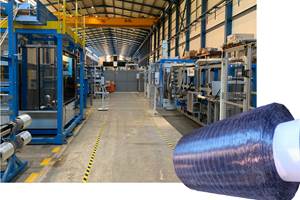Sereebo CFRTP sheets: "Saving the Earth"
Teijin’s carbon fiber/thermoplastic material, used in the CarbonPro pickup box, was developed with CO2 reduction in mind.
The trade name for Sereebo, Teijin Ltd.’s (Tokyo, Japan) carbon fiber-reinforced thermoplastic (CFRTP) sheets used in the manufacture of the CarbonPro pickup box, is an acronym for the English phrase “Save the Earth, REvolutionary & Evolutionary carBOn.” And company officials indicate that saving the earth was indeed a motivation for developing the material.
“Environmental concerns such as CO2 emission reductions and improvements in fuel efficiency are now global issues, so accelerated development of tough, lightweight eco-friendly composite components is a pressing task in the automotive industry,” explains Akio Nakaishi, Teijin Group corporate officer and Teijin Ltd. general manager of the composites business unit. He notes that carbon fiber-reinforced plastic (CFRP) already is widely used to reduce mass in many aerospace/aviation and industrial applications. However, thermoset-based CFRP composites are rarely used for products with high production volumes owing to their slow processing times and recycling challenges.
Nakaishi says that the company started accelerating its materials technology development efforts in 2008 when it launched the Teijin Composites Innovation Center for advanced composites research in Japan. From the start, automotive was said to be an important target market for the material, although the material will be appropriate for other markets and applications.
“To expand the use of CFRP for mass-produced industrial applications, in 2011 we developed the first technology for high-volume production of thermoplastic-formed CFRTP composites with a takt time of around 1 minute as the breakthrough to lead to increase use of high-performance, lightweight carbon fiber materials,” Nakaishi adds. He points out that selection of a thermoplastic resin alone didn’t guarantee success. “We developed intermediate materials suited for adoption in mass-production vehicles, new technologies for faster press-molding, as well as technologies for recycling — all of which are essential in promoting the use of CFRTP in high-volume, eco-friendly vehicles.”
As a materials supplier when the joint General Motors/Teijin development program began in 2011, Teijin focused on modeling techniques, extensive computer-aided engineering (CAE) work, and application and material validation testing to ensure Sereebo provided properties that met or exceeded GM’s expectations. The company also was involved in developing manufacturing strategies (including a processing method) for the material. Since Teijin’s acquisition of Continental Structural Plastics (CSP; Auburn Hills, Mich., U.S.) in 2017, its in-house expertise has expanded to cover the materials and manufacturing expertise needed to bring the composite to production readiness in line with GM’s start of production (SOP) date. “The project involved the dedication of significant resources to bring this best-in-class material to the market,” recalls Nakaishi.
Currently there are three major Sereebo product lines. The U Series features continuous, unidirectional carbon fiber in a sheet-form intermediate product with very high anisotropic strength in the machine direction. The I Series (used on the CarbonPro pickup box) features discontinuous/chopped fibers to offer a balance of moldability and isotropic properties in a sheet-form intermediate product. And the P Series features long fiber thermoplastic (LFT) pelletized products with high-strength carbon fiber for injection molded parts of high complexity that require higher performance than that of glass fiber alone. Nakaishi notes that this product is “…a promising material that will enable the recycling of CFRTP composites.”
The LFT version of Sereebo was first used in 2013 on commercial components for D5300 SLR cameras from Nikon Corp., Tokyo, Japan. The CarbonPro box not only is the automotive debut of the I Series Sereebo, but it also represents the world’s first commercial application for sheet-form Sereebo.
See CW’s June Focus on Design “Chopped carbon fiber, polyamide and innovation redefine the modern pickup truck” for more on Sereebo’s use in the CarbonPro pickup box.
Related Content
Materials & Processes: Composites fibers and resins
Compared to legacy materials like steel, aluminum, iron and titanium, composites are still coming of age, and only just now are being better understood by design and manufacturing engineers. However, composites’ physical properties — combined with unbeatable light weight — make them undeniably attractive.
Read MoreNovel dry tape for liquid molded composites
MTorres seeks to enable next-gen aircraft and open new markets for composites with low-cost, high-permeability tapes and versatile, high-speed production lines.
Read MorePEEK vs. PEKK vs. PAEK and continuous compression molding
Suppliers of thermoplastics and carbon fiber chime in regarding PEEK vs. PEKK, and now PAEK, as well as in-situ consolidation — the supply chain for thermoplastic tape composites continues to evolve.
Read MoreOne-piece, one-shot, 17-meter wing spar for high-rate aircraft manufacture
GKN Aerospace has spent the last five years developing materials strategies and resin transfer molding (RTM) for an aircraft trailing edge wing spar for the Airbus Wing of Tomorrow program.
Read MoreRead Next
CW’s 2024 Top Shops survey offers new approach to benchmarking
Respondents that complete the survey by April 30, 2024, have the chance to be recognized as an honoree.
Read MoreFrom the CW Archives: The tale of the thermoplastic cryotank
In 2006, guest columnist Bob Hartunian related the story of his efforts two decades prior, while at McDonnell Douglas, to develop a thermoplastic composite crytank for hydrogen storage. He learned a lot of lessons.
Read MoreComposites end markets: Energy (2024)
Composites are used widely in oil/gas, wind and other renewable energy applications. Despite market challenges, growth potential and innovation for composites continue.
Read More

























